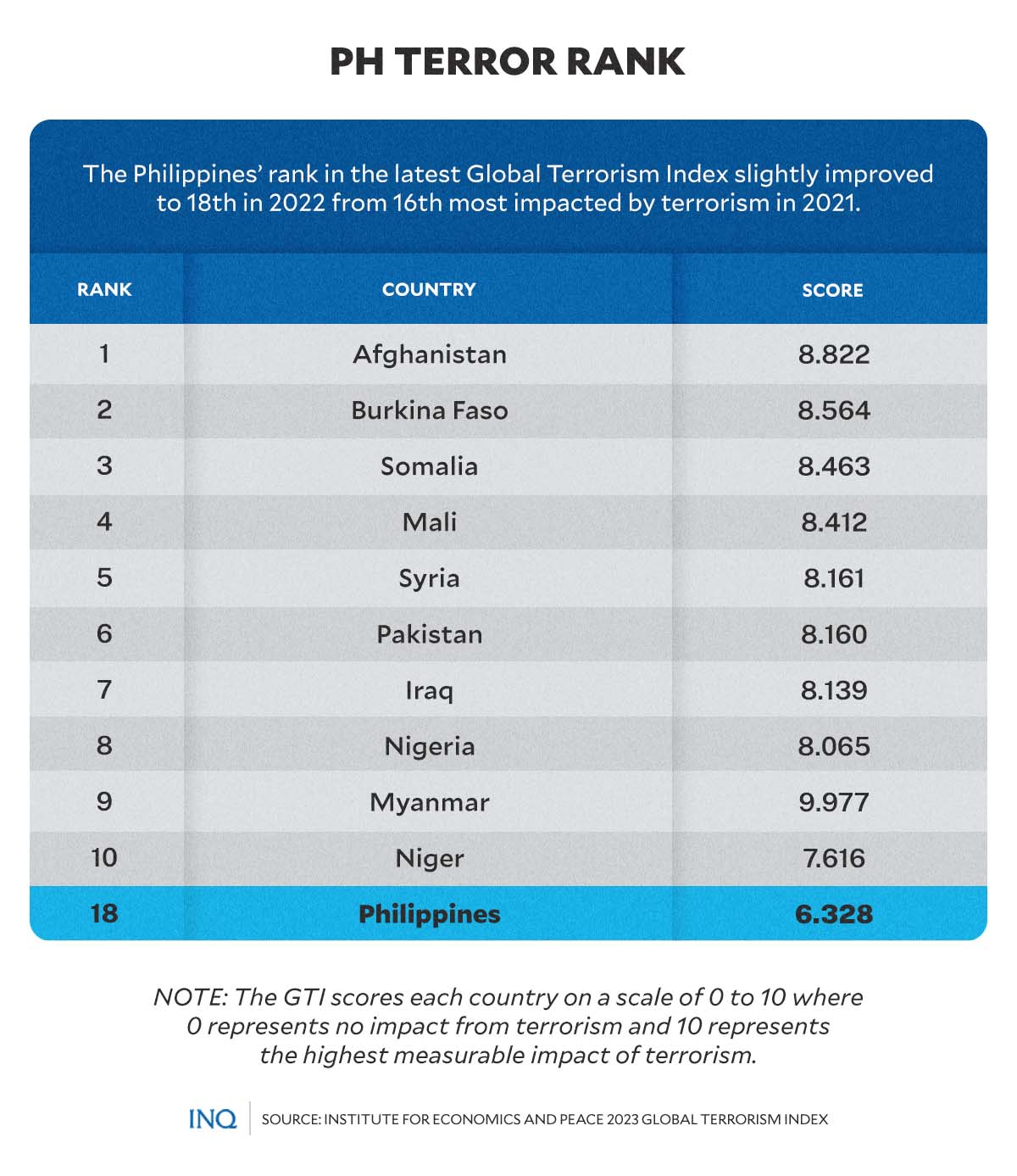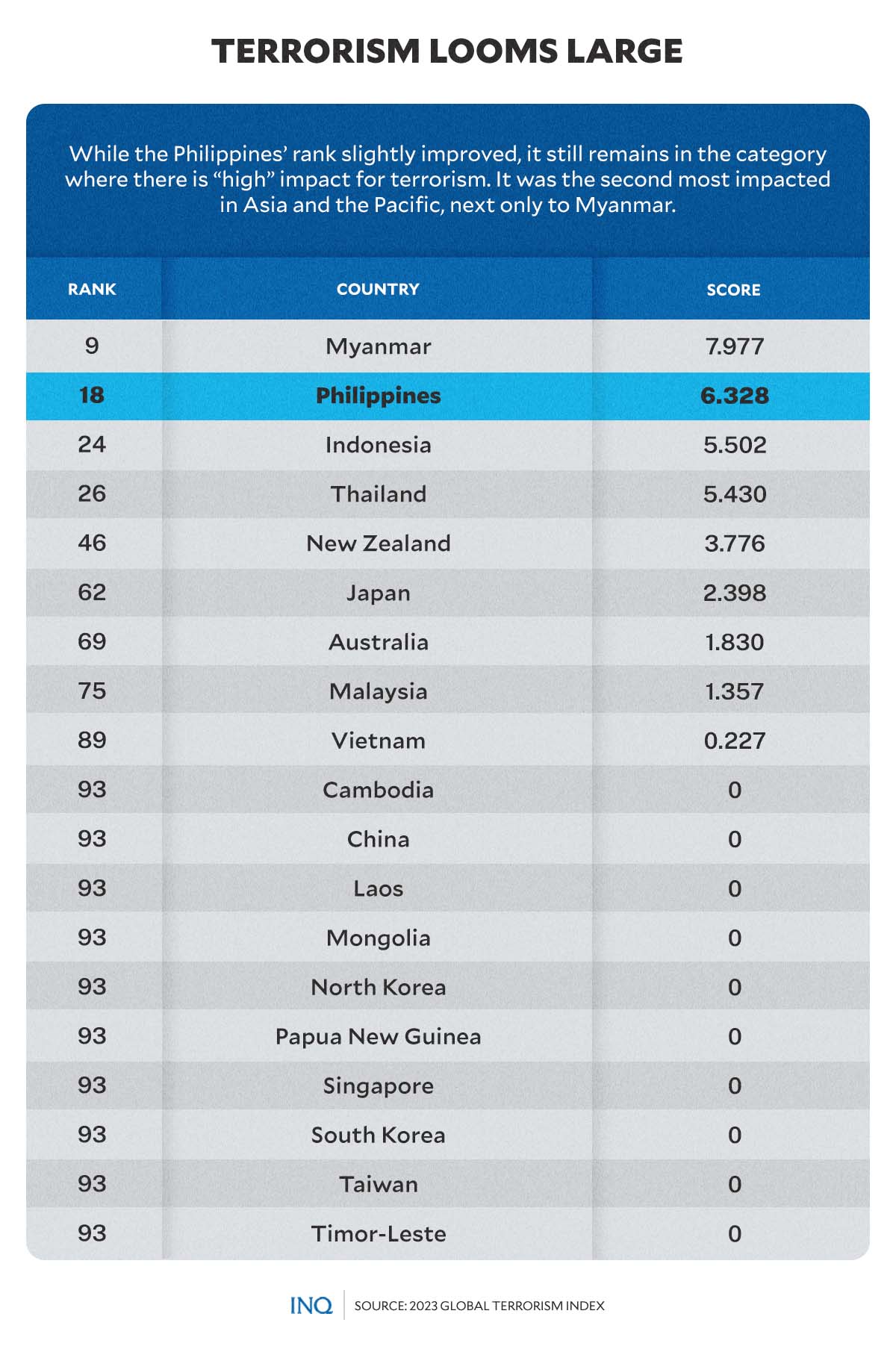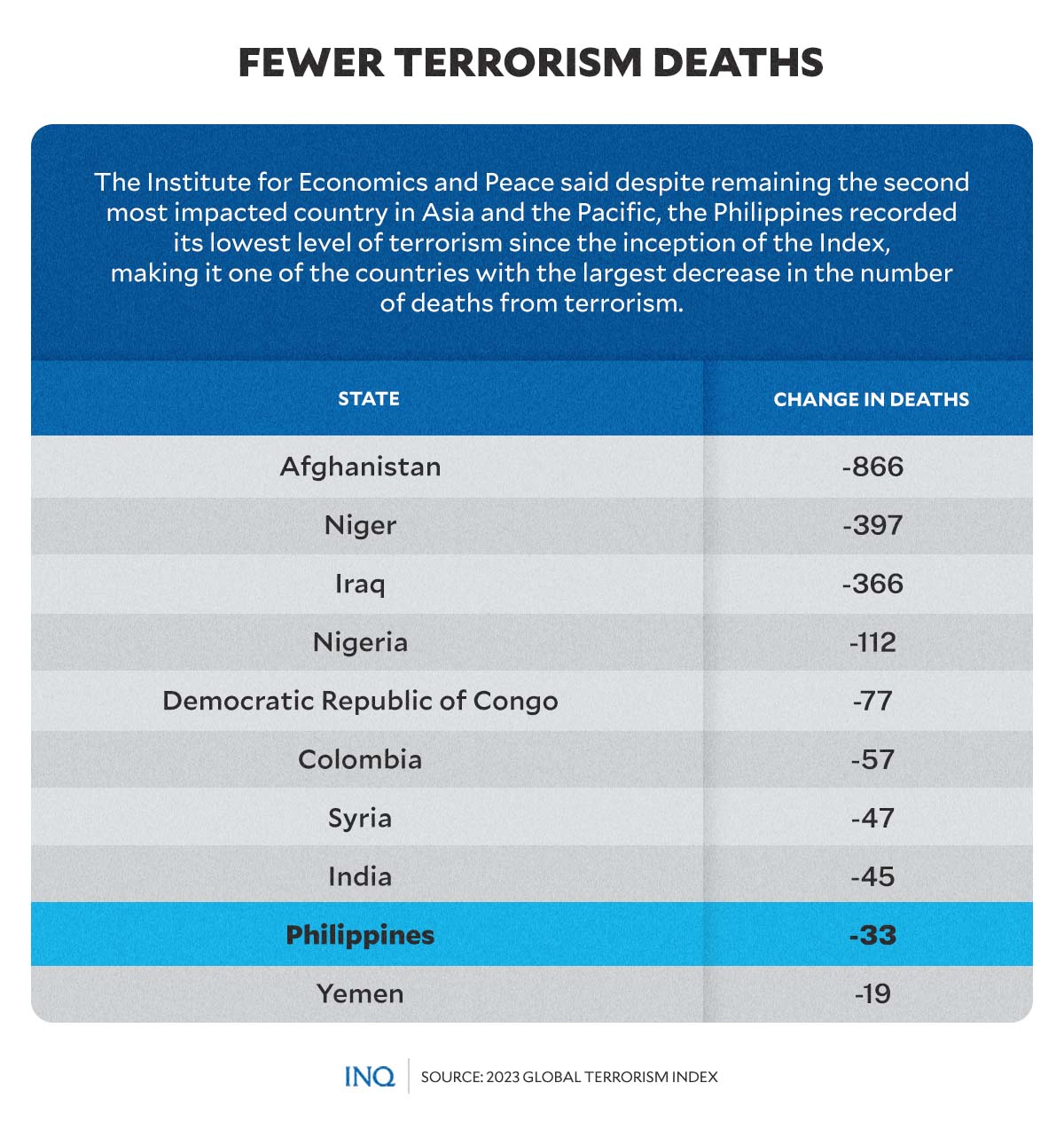Terror in PH: Fewer deaths, softer impact seen
MANILA, Philippines—As stressed by the government in 2020, “terrorism is a grave challenge to security and the human rights of individuals; it leaves destruction of societies and lives in its wake.”
This was the reason that as the Philippines is still considered highly impacted by terrorism despite its improvement in the 2023 Global Terrorism Index (GTI), the government committed to having the country removed from the list of terrorism-affected countries.
Based on the GTI, which is produced by the Institute for Economics and Peace (IEP), the Philippines improved its rank from 16th in 2021 to 18th in 2022 after having an overall score of 6.328, slightly lower than the previous 6.79.
As the IEP explained, the GTI scores each country on a scale of 0 to 10, where 0 represents no impact from terrorism and 10 represents the highest measurable impact of terrorism.
This was “welcome[d] with great enthusiasm and optimism” by the National Security Council (NSC), which stressed the Philippines’ improved ranking compared to being among the top 10 countries worst affected by terrorism several years ago.
Article continues after this advertisementAs stated by the IEP in the 2019 GTI, the Philippines was 13th most affected by terrorism in 2002, 8th in 2003, 10th in 2004, 12th in 2005, 14th in 2006, 12th in 2007, 8th in 2008, 9th in 2009, 9th in 2010, 10th in 2011, 11th in 2012, 9th in 2013, 11th in 2014, 12th in 2015 and 2016, 10th in 2017, 9th in 2018, and 10th in 2019.
Article continues after this advertisementIt said “such notoriety, according to the same reports, was due to the atrocities mostly committed by the communist terrorist group New People’s Army and armed groups affiliated with known international terrorist organizations,” the NSC said.
‘Lowest level’
The IEP said the Philippines had its “lowest level” of terrorism since the inception of the GTI, having only 20 attacks and 18 deaths in 2022, a fall of 68 percent and 65 percent, respectively, compared to 2021.
Providing a comprehensive study of key global trends and patterns in terrorism over the last decade, the calculation of the GTI score considers not only deaths but also incidents, hostages and injuries from terrorism, weighted over a five-year period.
The IEP also said the Philippines was one of the few countries that saw the largest decrease in the number of deaths from terrorism, next to India, Syria, Colombia, Democratic Republic of Congo, Nigeria, Iraq, Niger, and Afghanistan.
The Philippines, based on the GTI, saw 33 fewer deaths in 2022 compared to 2021. Afghanistan, meanwhile, had the most decrease at 866 fewer deaths, reversing 3 years of consecutive increases.
But despite the Philippines improving in its ranking, the IEP said it remains second worst affected by terrorism in Asia and the Pacific, next only to Myanmar, which was ranked 9th in the Index after having an overall score of 9.977.
The IEP said eight countries in Asia and the Pacific improved in 2022, while three deteriorated. This resulted in the impact of terrorism falling in the Asia-Pacific region for the fourth consecutive year.
This, as eight countries showed no change in score last year, while Myanmar (9.977), Japan (2.398) and Indonesia (5.502) were the only countries in the region to record a deterioration in the impact of terrorism over the past year.
“Overall, the region improved by nine percent within the last year, the fifth largest improvement of all the regions in 2022. The average impact of terrorism in the region is now at its lowest level since 2013,” the IEP said.
‘Waning insurgency’
As explained by the Global Community Engagement and Resilience Fund, in late 2021, then President Rodrigo Duterte signed a law extending the transition period of the Bangsamoro Autonomous Region in Muslim Mindanao until 2025.
“This has been seen as a positive move by grantees, given the slow rate of promised change in the region. A longer transition is seen as more likely to herald more inclusive representation,” it said.
READ: Anti-Terror Law constitutional except for two parts, says SC
Likewise, the NSC said “the Philippine government is on the right track and by that we shall continue all counterinsurgency efforts we started years back, focusing mainly on our local peace initiatives and good governance espoused by the NTF-ELCAC.”
The NTF-ELCAC, or the National Task Force Against Local Communist Armed Conflict, was established in 2018 to implement a whole-of-nation approach in achieving “inclusive and sustainable peace.”
The improvement in the GTI, it said, is a testament to the government’s unrelenting resolve to address the root causes of insurgency through the implementation of landmark measures, which include these:
- Bangsamoro Organic Law
- Creation of the NTF-ELCAC through Executive Order No. 70
- Aggressive campaign in Preventing and Countering Violent Extremism
- Anti-Terrorism Act
READ: ‘I don’t care about human rights’: Duterte and the failure to see human rights’ role in progress
Consequences of gov’t war vs terrorism
However, these measures have consequences, rights group Karapatan said in its term-ender report that was published on Tuesday (April 18), detailing how Duterte “left an indelible legacy of impunity and a massive human rights crisis.”
It said while Duterte’s Oplan Kapanatagan merely adopted the previous administrations’ “whole-of-nation” approach, this was made more systematic, insidious and thorough with the institutionalization of NTF-ELCAC.
“Through its clusters, the NTF-ELCAC became the main machinery in a dangerous campaign of rabid red-tagging, vilification and harassment targeting activists, human rights defenders, environmentalists, peasant organizers, unionists, indigenous leaders, lawyers, and church workers by publicly vilifying them and their organizations as so-called ‘fronts’ of ‘communist-terrorist’ groups,” Karapatan said.
READ: Badoy says red-tagging not dangerous but 427 slain activists show otherwise
It stressed that the government made no distinction between actual combatants in the underground armed resistance and activists in the open legal democratic movement.
“This non-distinction was used as an excuse to attack leaders and members
of people’s organizations, progressive party-list groups, and vocal critics of the government.”
From July 2016 to June 2022, 422 activists had fallen victims to extrajudicial killings, Karapatan said, with Bicol Region having the highest number of deaths at 64, followed by Southern Mindanao (63), Central Visayas (56), and Western Visayas (54).



